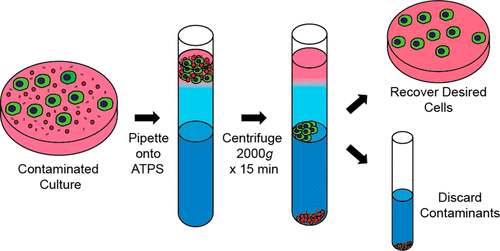当前位置:
X-MOL 学术
›
Anal. Chem.
›
论文详情
Our official English website, www.x-mol.net, welcomes your
feedback! (Note: you will need to create a separate account there.)
Enrichment and Recovery of Mammalian Cells from Contaminated Cultures Using Aqueous Two-Phase Systems
Analytical Chemistry ( IF 6.7 ) Pub Date : 2018-01-12 00:00:00 , DOI: 10.1021/acs.analchem.7b04352 Christopher J. Luby 1 , Benjamin P. Coughlin 1 , Charles R. Mace 1
Analytical Chemistry ( IF 6.7 ) Pub Date : 2018-01-12 00:00:00 , DOI: 10.1021/acs.analchem.7b04352 Christopher J. Luby 1 , Benjamin P. Coughlin 1 , Charles R. Mace 1
Affiliation

|
This Article describes a density-based method for removing contaminants, including microorganisms and nonviable cells, from mammalian cell cultures using an aqueous two-phase system (ATPS). The properties of a 7% w/w polyethylene glycol (PEG)–11% w/w Ficoll ATPS can be tuned to prepare a biocompatible system that removes contaminants with little to no adverse effects on the viability or growth of the cultured cells after treatment. This system can be used to enrich cell culture populations for viable cells and to reduce the number of microorganism contaminants in a culture, which increases the chances of subsequent antibiotic treatments being successful. We test the effectiveness of our method in model contaminated cultures of both adherent (HeLa) and suspension (HL-60 II) mammalian cells contaminated with bacteria (E. coli) and yeast (S. cerevisiae). An average of 70.2 ± 4.6% of HeLa cells added to the system are subsequently recovered, and 55.9 ± 2.1% of HL-60 II cells are recovered. After sedimenting to the interface of the ATPS, these cells have an average viability of 98.0 ± 0.2% and 95.3 ± 2.2%, respectively. By removing unwanted cells, desired cell populations can be recovered, and cultures that would otherwise need to be discarded can continue to be used.
中文翻译:

使用两相水系统从受污染的培养物中富集和回收哺乳动物细胞
本文介绍了一种使用水两相系统(ATPS)从哺乳动物细胞培养物中去除污染物(包括微生物和非活细胞)的基于密度的方法。可以调整7%w / w的聚乙二醇(PEG)–11%w / w的Ficoll ATPS的特性,以制备生物相容性系统,该系统可以去除污染物,对处理后的细胞存活或生长几乎没有不利影响。该系统可用于富集活细胞的细胞培养种群,并减少培养物中微生物污染物的数量,这增加了后续抗生素治疗成功的机会。我们测试了我们的方法在被细菌污染的粘附(HeLa)和悬浮液(HL-60 II)哺乳动物细胞均受模型污染的培养物中的有效性(大肠杆菌(E. coli)和酵母(S. cerevisiae)。随后回收平均添加到系统中的70.2±4.6%的HeLa细胞,并回收55.9±2.1%的HL-60 II细胞。沉积到ATPS的界面后,这些细胞的平均生存力分别为98.0±0.2%和95.3±2.2%。通过去除不需要的细胞,可以回收所需的细胞群,并且可以继续使用原本需要丢弃的培养物。
更新日期:2018-01-12
中文翻译:

使用两相水系统从受污染的培养物中富集和回收哺乳动物细胞
本文介绍了一种使用水两相系统(ATPS)从哺乳动物细胞培养物中去除污染物(包括微生物和非活细胞)的基于密度的方法。可以调整7%w / w的聚乙二醇(PEG)–11%w / w的Ficoll ATPS的特性,以制备生物相容性系统,该系统可以去除污染物,对处理后的细胞存活或生长几乎没有不利影响。该系统可用于富集活细胞的细胞培养种群,并减少培养物中微生物污染物的数量,这增加了后续抗生素治疗成功的机会。我们测试了我们的方法在被细菌污染的粘附(HeLa)和悬浮液(HL-60 II)哺乳动物细胞均受模型污染的培养物中的有效性(大肠杆菌(E. coli)和酵母(S. cerevisiae)。随后回收平均添加到系统中的70.2±4.6%的HeLa细胞,并回收55.9±2.1%的HL-60 II细胞。沉积到ATPS的界面后,这些细胞的平均生存力分别为98.0±0.2%和95.3±2.2%。通过去除不需要的细胞,可以回收所需的细胞群,并且可以继续使用原本需要丢弃的培养物。











































 京公网安备 11010802027423号
京公网安备 11010802027423号